Chemical and Petrographic Characterization of Stone and Glass Tesserae in the Nereid and Geometric Mosaics from the S. Aloe Quarter in Vibo Valentia–Calabria, Italy
Abstract
:1. Introduction
2. The Archaeological Site of the S. Aloe Quarter
3. Material and Methods
4. Results and Discussion
4.1. Petrographic Study
4.1.1. Results
Black Tesserae
White Tesserae
Pinkish/Reddish Tesserae
Greenish Tessera
4.1.2. Discussion
4.2. Chemical Study
4.2.1. Stone Tesserae
White Tesserae
4.2.2. Glass Tesserae
Major and Minor Elements
Trace Elements
5. Conclusions
- (1)
- The white, pinkish/reddish and black tesserae are all made of stones. The majority of them are limestones, except for one white tessera constituted by marble, probably of Greek provenance (Pentelicon) and two black tesserae made of volcanic rocks;
- (2)
- The blue/ light-blue, yellow tesserae are made of glass;
- (3)
- The green tesserae are made of two types of materials: stone and glass.
Author Contributions
Funding
Acknowledgments
Conflicts of Interest
References
- Rotella, A.M. Il parco archeologico in località S. In Aloe a Vibo Valentia: Problematiche di Tutela e di Fruizione tra Nuove Scoperte e Vecchi Scavi; Consenso Publishing: Corigliano-Rossano (CS), Italy, 2009; Volumes 3–4, pp. 178–191. [Google Scholar]
- Ricciardi, P.; Colomban, P.; Tournie, A.; Macchiarola, M.; Ayed, N. A non-invasive study of Roman Age mosaic glass tesserae by means of Raman spectroscopy. J. Archaeol. Sci. 2009, 36, 2551–2559. [Google Scholar] [CrossRef]
- Barca, D.; Basso, E.; Bersani, D.; Galli, G.; Invernizzi, C.; La Russa, M.F.; Lottici, P.P.; Malagodi, M.; Ruffolo, S.A. Vitreous tesserae from the calidarium mosaics of the Villa dei Quintili, Rome. Chemical composition and production technology. Microchem. J. 2016, 124, 726–735. [Google Scholar] [CrossRef]
- Verità, M.; Lazzarini, L.; Tesser, E.; Antonelli, F. Villa del Casale (Piazza Armerina, Sicily): Stone and glass tesserae in the baths floor mosaics. Archaeol. Anthrop. Sci. 2017, 11, 373–385. [Google Scholar] [CrossRef]
- Silvestri, A. The coloured glass of Iulia Felix. J. Archaeol. Sci. 2008, 35, 1489–1501. [Google Scholar] [CrossRef]
- Silvestri, A.; Molin, G.; Salviulo, G. Roman and Medieval glass from the Italian area: Bulk characterisation and relationships with production technology. Archaeometry 2005, 47, 797–816. [Google Scholar] [CrossRef]
- Silvestri, A.; Molin, G.; Salviulo, G. The colourless glass of Iulia Felix. J. Archaeol. Sci. 2008, 35, 331–341. [Google Scholar] [CrossRef]
- Foster, H.E.; Jackson, C.M. The composition of ‘naturally coloured’ late Roman vessel glass from Britain and the implications for models of glass production and supply. J. Archaeol. Sci. 2009, 36, 189–204. [Google Scholar] [CrossRef]
- Basso, E.; Invernizzi, C.; Malagodi, M.; La Russa, M.F.; Bersani, D.; Lottici, P.P. Characterization of colorants and opacifiers in roman glass mosaic tesserae through spectroscopic and spectrometric techniques. J. Raman Spectrosc. 2014, 45, 238–245. [Google Scholar] [CrossRef]
- Paynter, S.; Kearns, T. West Clacton Reservoir, Great Benteley, Essex: Analysis of Glass Tesserae; Research Department Report Series no 44; English Heritage: London, UK, 2011. [Google Scholar]
- Silvestri, A.; Tonietto, S.; Molin, M.; Guerriero, P. The palaeo-Christian glass mosaic of St. Prosdocimus (Padova, Italy): Archaeometric characterisation of tesserae with antimony- or phosphorus-based opacifiers. J. Archaeol. Sci. 2012, 39, 217. [Google Scholar] [CrossRef]
- Verità, M.; Maggetti, M.; Saguì, L.; Santopadre, P. Colors of Roman glass: An investigation of the yellow sectilia in Gorga collection. J. Glass Studies 2013, 55, 21–34. [Google Scholar]
- Shortland, A.J. Evaporites of the Wadi Natrun: Seasonal and annual variation and its implication for ancient exploitation. Archaeometry 2006, 46, 497–516. [Google Scholar] [CrossRef]
- Freestone, I.C. The Provenance of Ancient Glass through Compositional Analysis. Mater. Res. Soc. Symp. Proc. Mater. Res. Soc. 2005, 852, OO8.1.1–OO8.1.14. [Google Scholar] [CrossRef]
- Freestone, I.C.; Pointing, M.; Hughes, M.J. The origins of Byzantine glass from Maroni Petrera, Cyprus. Archaeometry 2002, 44, 257–272. [Google Scholar] [CrossRef]
- Gambino, F.; Borghi, A.; d’Atri, A.; Gallo, L.M.; Ghiraldi, L.; Giardino, M.; Martire, L.; Palomba, M.; Perotti, L.; Macadam, J. TOURinSTONES: A Free Mobile Application for Promoting Geological Heritage in the City of Torino (NW Italy). Geoheritage 2019, 11, 12019. [Google Scholar] [CrossRef]
- Arslan, E. Vibo Valentia. In Enciclopedia dell’Arte Antica II Supplemento; Treccani: Roma, Italy, 1997; Volume VII, p. 1162. [Google Scholar]
- Sogliani, F. Repertorio delle fonti scritte per la ricostruzione della vicenda insediativa di Vibo Valentia tra Tarda Antichità e medioevo, Sulle tracce della Storia; Studi in onore di Vincenzo Nusdeo nel decennale della scomparsa; D’Andrea, M., Ed.; ADHOC: Vibo Valentia, Italy, 2012; pp. 271–335. [Google Scholar]
- Faedo, L. Aspetti della cultura figurativa in età romana. In Storia Della Calabria Antica. 2. Età Italica e Romana; Settis, S., Ed.; Gangemi: Roma, Italy, 1994; pp. 601–605. [Google Scholar]
- Iannelli, M.T.; Guzzo, P.G.; Gaglianese, G.; Minniti, B.; Rotella, A.M.; Vivacqua, P. Hipponion tra la seconda metà del IV e la fine del III sec. a.C.: Ricostruzione topografica alla luce di nuove scoperte. In Enotri e Brettii in Magna Grecia Modi e Forme di Interazione Culturale; De Sensi Sestito, G., Mancuso, S., Eds.; Rubettino: Soveria Mannelli (CZ), Italy, 2017; Volume II, pp. 397–510. [Google Scholar]
- Rotella, A.M. L’indagine archeologica nel quartiere romano di S. Aloe. In Hipponion Vibo Valentia Monsleonis. I volti della città; Iannelli, M.T., Ed.; Laruffa: Reggio Calabria, Italy, 2014; pp. 117–134. [Google Scholar]
- Harrys Reyes, F.; Miranda, L. Il restauro di due mosaici pavimentali nel parco archeologico di S. Aloe a Vibo Valentia, Collana Esperide; Consenso Publishing: Corigliano-Rossano (CS), Italy, 2009; Volumes 3–4, pp. 168–177. [Google Scholar]
- Sangineto, A.B. Scavi Nell’abitato Romano di Vibo Valentia, in Annali della Scuola Normale di Pisa; All’insegna del Giglio: Firenze, Italy, 1989; Volume S. III, 19, pp. 833–843. [Google Scholar]
- Gunther, D.; Heinrich, C.A. Enhanced sensitivity in laser ablation-ICP mass spectrometry using helium-argon mixtures as aerosol carrier. J. Anal. Atom. Spectrom. 1999, 14, 1363–1368. [Google Scholar] [CrossRef]
- Barca, D.; Abate, M.; Crisci, G.M.; De Presbiteris, D. Post-Medieval glass from the castle of Cosenza, Italy: Chemical characterization by LA-ICP-MS and SEM-EDS. Periodico Mineral. 2009, 78, 49–64. [Google Scholar] [CrossRef]
- Barca, D.; Lucarini, G.; Fedele, F. Provenance of obsidian artefacts from the WāDī ATH- THAYYILAH 3 Neolithic site (eastern Yemen plateau) by LA-ICP-MS. Archaeometry 2012, 54, 603–622. [Google Scholar] [CrossRef]
- Fryer, B.J.; Jackson, S.E.; Longerich, H.P. The design, operation and role of the laser ablation microprobe coupled with an inductively coupled plasma-mass spectrometer (LAM-ICP-MS) in the earth sciences. Can. Mineral. 1995, 33, 303–312. [Google Scholar]
- Gao, S.; Liu, X.; Yuan, H.; Hattendorf, B.; Gunther, D.; Chen, L.; Hu, S. Determination of forty-two major and trace elements in USGS and NIST SRM glasses by laser ablation-inductively coupled plasma mass spectrometry. Geostandard Newslett. 2002, 26, 181–196. [Google Scholar] [CrossRef]
- Pearce, N.J.G.; Perkins, W.T.; Westgate, J.A.; Gorton, M.T.; Jackson, S.E.; Neal, C.R.; Chenery, S.P. A compila- tion of new and published major and trace element data for NIST SRM 610 and SRM 612 glass reference materials. Geostandard Newslett. 1997, XXI, 114–115. [Google Scholar]
- Marsaglia, K.M. Petrography and provenance of volcaniclastic sands recovered from the Izu-Bonin Arc, Leg 126. Proceedings of the Ocean Drilling Program. Sci. Results 1992, 126, 139–154. [Google Scholar]
- Marsaglia, K.M. Basaltic island sand provenance. In Processes Controlling the Composition of Clastic Sediments; Johnsson, M.J., Basu, A., Eds.; Geological Society of America Bulletin: Boulden, CO, USA, 1993; Volume 284, pp. 41–65. [Google Scholar]
- Morrone, C.; De Rosa, R.; Le Pera, E.; Marsaglia, K.M. Provenance of volcaniclastic beach sand in a magmatic-arc setting: An example from Lipari island (Aeolian archipelago, Tyrrhenian Sea). Geol. Mag. 2017, 154, 804–828. [Google Scholar] [CrossRef]
- Folk, R.L. Practical petrographic classification of limestones. Bull. Am. Assoc. Petrol. Geol. 1959, 43, 1–38. [Google Scholar]
- Dunham, R.J. Classification of carbonate rocks according to depositional texture. In Classification of Carbonate Rocks; Ham, W.E., Ed.; The American Association of Petroleum Geologists: Tulsa, OK, USA, 1962; Volume 1, pp. 108–121. [Google Scholar]
- Worden, R.H.; Armitage, P.J.; Butcher, A.R.; Churchill, J.; Csoma, A.; Hollis, C.; Lander, R.; Omma, J. Petroleum reservoir quality prediction: Overview and contrasting approaches from sandstone and carbonate communities. In Reservoir Quality of Clastic and Carbonate Rocks: Analysis, Modelling and Prediction; Worden, R.H., Ed.; Geological Society: London, UK, 2018; p. 435. [Google Scholar] [CrossRef]
- Andò, S.; Garzanti, E. Raman spectroscopy in heavy-mineral studies. In Sediment Provenance Studies in Hydrocarbon Exploration and Production; Scott, R.A., Smyth, H.R., Morton, A.C., Richardson, N., Eds.; Geological Society: London, UK, 2013; Volume 386, pp. 395–412. [Google Scholar]
- Le Pera, E.; Morrone, C. Heavy minerals distribution and provenance in modern beach sands of Campania, Italy. Rend. Online Soc. Geol. It. 2018, 45, 136–140. [Google Scholar] [CrossRef]
- Morton, A.C.; Johnsson, M.J. Factors influencing the composition of detrital heavy mineral suites. In Holocene Sands of the Apure River Drainage Basin, Venezuela. In Processes Controlling the Composition of Clastic Sediments; Johnsson, M.J., Basu, A., Eds.; Geological Society of America: Boulder, CO, USA, 1993; Volume 284, pp. 171–185. [Google Scholar]
- Basu, A.; Molinaroli, E. Provenance characteristics of detrital opaque Fe-Ti oxides minerals. J. Sediment. Petrol. 1989, 59, 922–934. [Google Scholar]
- Basu, A.; Molinaroli, E. Reliability and application of detrital Fe-Ti oxide minerals in provenance determination. Geol. Soc. Lond. Special Publ. 1991, 57, 55–65. [Google Scholar] [CrossRef]
- Caracciolo, L.; Gramigna, P.; Critelli, S.; Calzona, A.B.; Russo, F. Petrostratigraphic analysis of a LateMiocene mixed siliciclastic–carbonate depositional system (Calabria, Southern Italy): Implications for Mediterranean paleogeography. Sediment. Geol. 2013, 284/285, 117–132. [Google Scholar] [CrossRef]
- Rao, A.; Gramigna, P.; Neri, C. Aspetti sedimentologici e biostratigrafici della sezione neogenica di Piscopio nell’area del M.te Poro, Vibo Valentia (Calabria). Geol. Romana 2007, 40, 147–161. [Google Scholar]
- Attanasio, D.; Armiento, G.; Brilli, M.; Emanuele, M.C.; Platania, R.; Turi, B. Multimethod marble provenance determinations: The Carrara marbles as a case study for the combined use of isotopic, electron spin resonance and petrographic data. Archaeometry 2000, 42, 257–272. [Google Scholar] [CrossRef]
- Belfiore, M.C.; Ricca, M.; La Russa, M.F.; Ruffolo, S.A.; Galli, G.; Barca, D.; Malagodi, M.; Vallefuoco, M.; Sprovieri, M.; Pezzino, A. Provenance study of building and statuary marbles from the Roman archaeological site of “Villa dei Quintili” (Rome, Italy). Ital. J. Geosci. 2016, 135, 236–249. [Google Scholar] [CrossRef]
- Gorgoni, C.; Lazzarini, L.; Pallante, P.; Turi, B. An updated and detailed mineropetrographic and C-O stable isotopic reference database for the main Mediterranean marbles used in antiquity. In Fifth International Conference of the Association for the Study of Marble and Other Stones in Antiquity, Museum of fine arts, Boston, U.S.A., June 1998; Herrmann, J.J., Herz, N., Newman, R., Eds.; Archetype Publications: London, UK, 2002; pp. 1–25. [Google Scholar]
- Capedri, S.; Venturelli, G. Accessory minerals as tracers in the provenancing of archaeological marbles, used in combination with isotopic and petrographic data. Archaeometry 2004, 46, 517–536. [Google Scholar] [CrossRef]
- La Russa, M.F.; Ruffolo, S.A.; Ricca, M.; Ricci, S.; Davidde, B.; Barca, D.; Capristo, V. A multidisciplinary approach to the study of underwater artefacts: The caseof a Tritone Barbato marble statue (Grotta Azzurra, Island of Capri, Naples). Per. Mineral. 2013, 82, 101–111. [Google Scholar]
- Miriello, D.; Malagodi, M.; Ruffolo, S.A.; La Russa, M.F.; Crisci, G.M.; Pezzino, A.; Galluccio, R.; Barca, D.; Marasco, E. Diagnostic, deterioration and provenance of stone materials from the Jefferson Page tomb (Non-Catholic Cemetery of Rome, Italy). Environ. Earth Sci. 2010, 60, 829–836. [Google Scholar] [CrossRef]
- Ricca, M.; La Russa, M.F.; Ruffolo, S.A.; Davidde, B.; Barca, D.; Crisci, G.M. Mosaic marble tesserae from the underwater archaeological site of Baia (Naples, Italy): Determination of the provenance. Eur. J. Mineral. 2014, 26, 323–331. [Google Scholar] [CrossRef]
- Ricca, M.; Belfiore, C.M.; Ruffolo, S.A.; Barca, D.; Alvarez De Buergo, M.; Crisci, G.M.; La Russa, M.F. Multi-analytical approach applied to the provenance study of marbles used as covering slabs in the archaeological submerged site of Baia (Naples, Italy): The case of the “Villa con ingresso a protiro”. Appl. Surface Sci. 2015, 357, 1369–1379. [Google Scholar] [CrossRef]
- Freestone, I.C. Chemical analysis of “raw” glass fragments. In Excavation of Chartage, The Circular Harbour; Hurst, H.R., Ed.; Oxford University Press: Oxford, UK, 1994; Volume II. [Google Scholar]
- Gratuze, B. Etude des Perles Protohistoriques en Verre du Tumulus de Courtesoult (Haute-Saône); IRAMAT, Institute de Recherche sur les Archéomatériaux, Centre Ernest Babelon, CNRS: Orléans, France, 2004. [Google Scholar]
- Hellemans, K.; Cagno, S.; Bogana, L.; Janssens, K.; Mendera, M. LA-ICP-MS labels early medieval Tuscan finds from Siena and Donoratico s late natron glass. J. Archaeol. Sci. Rep. 2019, 23, 844–853. [Google Scholar] [CrossRef]
- Angelini, I.; Gratuze, B.; Artioli, G. Glass and other vitreous materials through history. EMU Notes Mineral. 2019, 20, 87–150. [Google Scholar]
- Fisher, K.; Puchelt, H. Barium. In Handbook of Geochemistry, Elements Kr (36) to Ba (56); Wedepohl, K.H., Ed.; Springer: Berlin, Germany, 2009; pp. 56A1–56O2. [Google Scholar]
- Lahlil, S.; Biron, I.; Galoisy, L.; Morin, G. Rediscovering ancient glass technologies through the examination of opacifier crystals. J. Appl. Phys. A Mater. Sci. Process. 2008, 92, 109–116. [Google Scholar] [CrossRef]
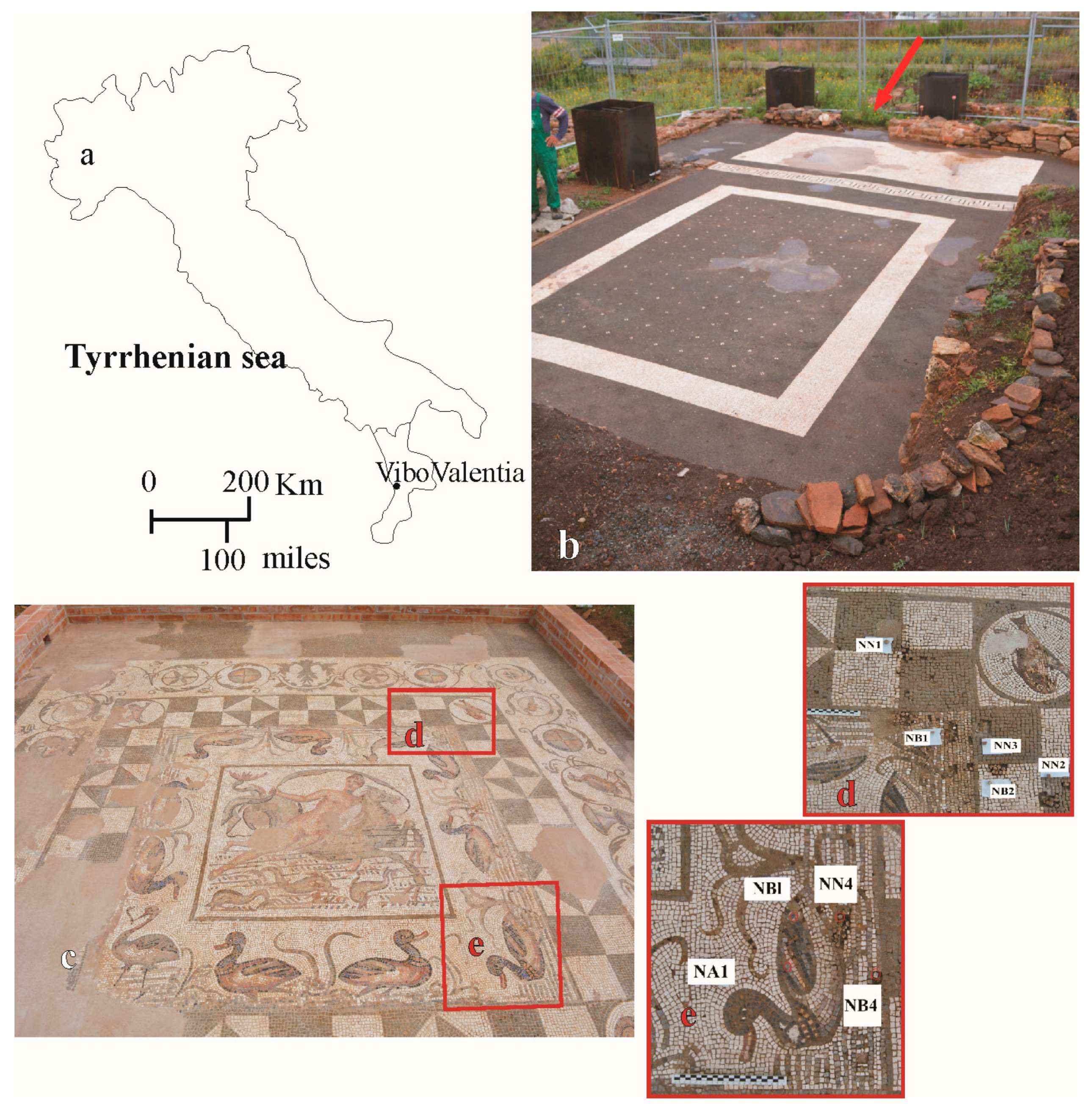
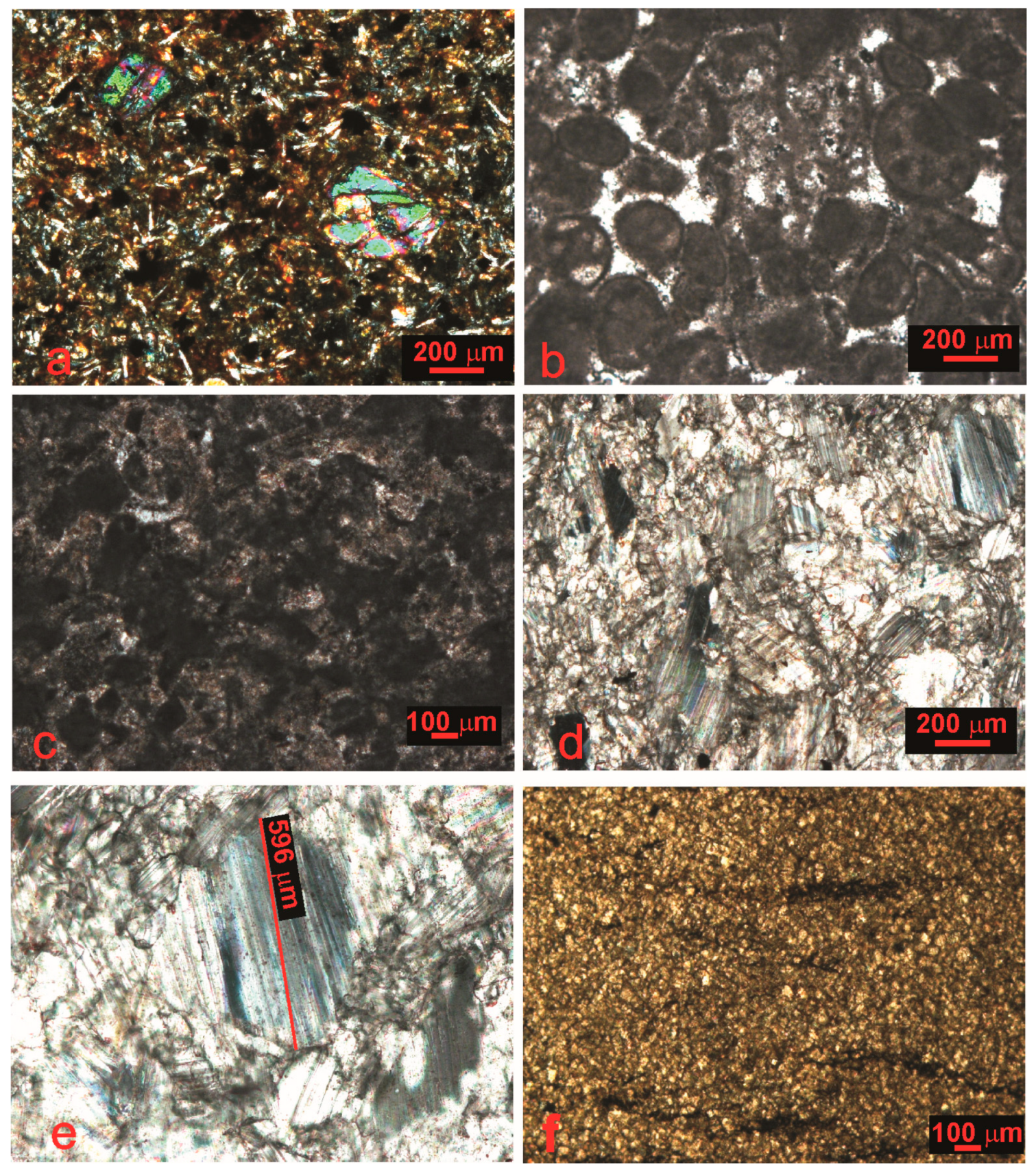
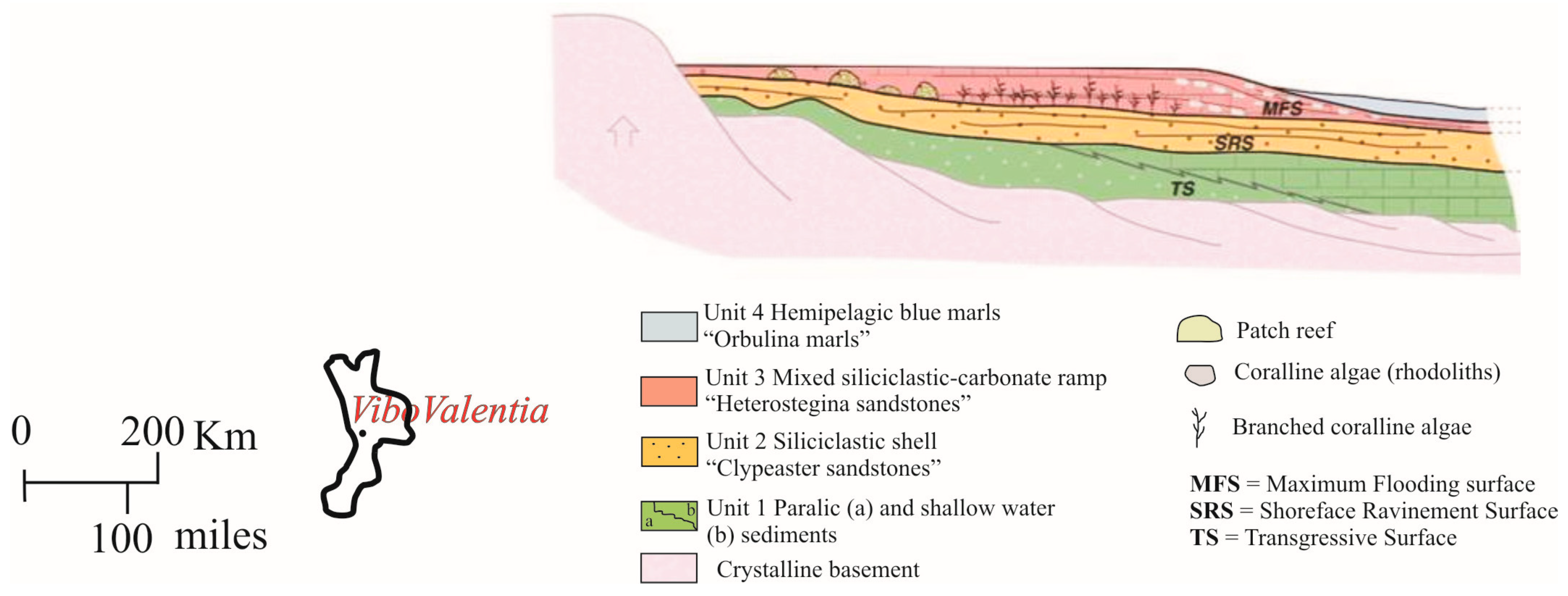


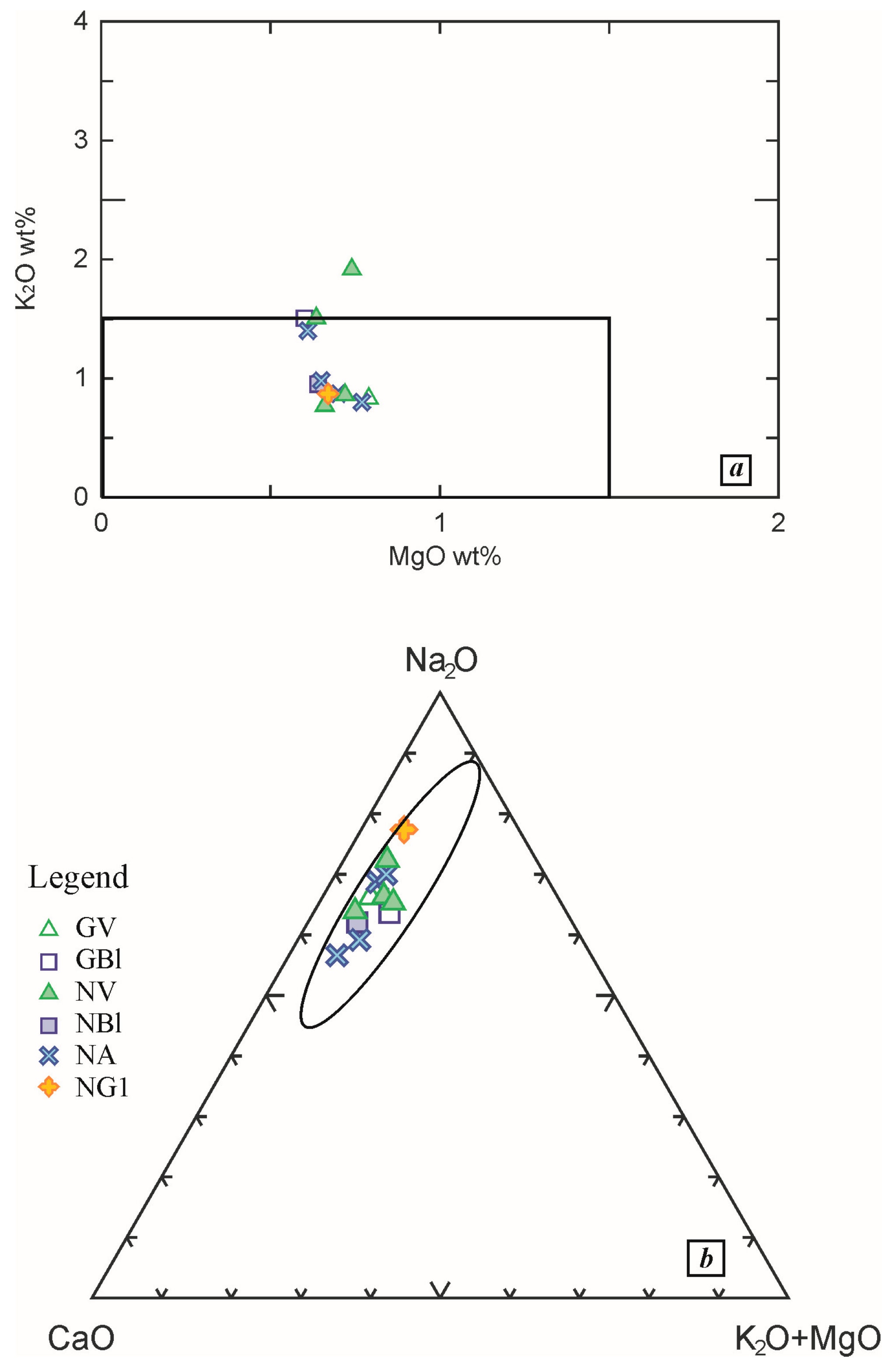
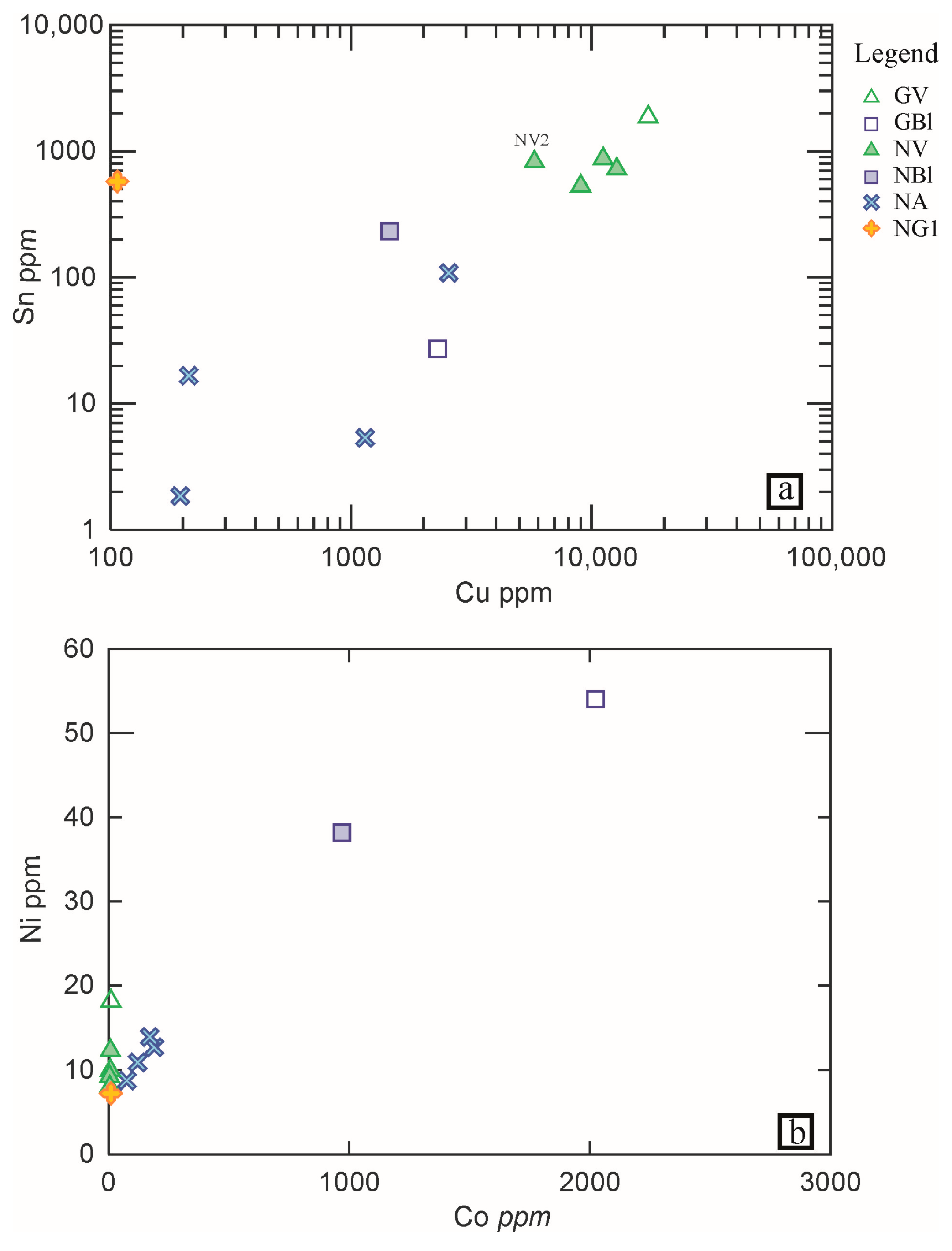
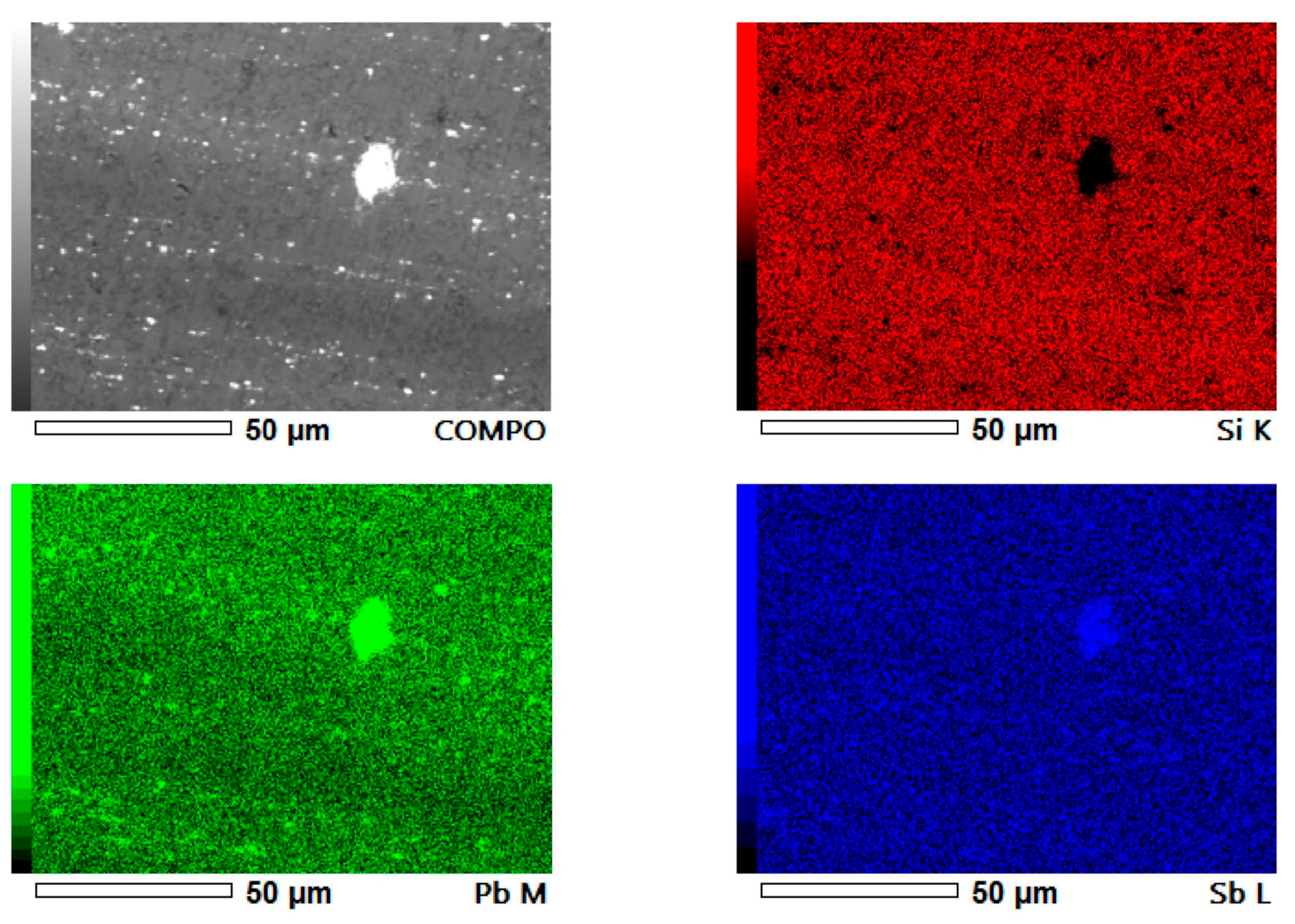

| Stone Tesserae Nereid Mosaic | Opaque Glass Tesserae Nereid Mosaic | |||
| Label | Color | Type | Label | Color |
| NB1 | White | Oolithic limestone | NA1, NA2, NA3, NA4 | Light blue |
| NB2, NB3 | White | Peloidal limestone | NBl | Blue |
| NB4 | White | Marble | NV1, NV4 | Dark green |
| NN1, NN2 | Black | Basalt/andesitic–basalt | NV2 | Light green |
| NN3 | Black | Biomicritic limestone | NV3 | Green/turquoise |
| NN4 | Black | Microsparitic limestone | NG1 | Yellow |
| NRR1 | Pinkish | Microsparitic limestone | Opaque Glass Tesserae Geometric mosaic | |
| NRR2 | Reddish | Micritic limestone | Label | Color |
| NVR1 | Greenish | Micritic limestone | GBl | Blue |
| - | - | - | GV | Green |
| BCR-2G | NIST-SRM610 | |||||||||
|---|---|---|---|---|---|---|---|---|---|---|
| Gao et al. [28] | This Study (1) | Accuracies (2) | Gao et al. [28] | This Study (1) | Accuracies (2) | |||||
| Concentrations | Std | Concentrations | Std | Concentrations | Std | Concentrations | Std | |||
| Ti | 13,005 | 1081 | 13,512 | 363 | 3.89 | 434 | 9 | 422 | 11 | −2.76 |
| V | 425 | 7 | 418 | 7.7 | −1.65 | 442 | 5 | 453 | 7 | 2.49 |
| Cr | 17 | 2 | 15.9 | 0.2 | −6.47 | 404 | 7 | 412 | 5 | 1.98 |
| Mn | 1463 | 23 | 1456 | 24.6 | −0.48 | 435 | 5 | 427 | 7 | −1.84 |
| Co | 38 | 1 | 37.1 | 1.4 | −2.37 | 405 | 5 | 417 | 8 | 2.96 |
| Cu | 18 | 1 | 16.7 | 0.9 | −7.22 | 430 | 11 | 421 | 12 | −2.09 |
| Ni | 12.7 | 0.9 | 11.9 | 0.2 | −6.30 | 445 | 12 | 428 | 10 | −3.82 |
| Rb | 51 | 3 | 49 | 0.6 | −3.92 | 431 | 6 | 427 | 21 | −0.93 |
| Sr | 321 | 6 | 333 | 4.9 | 3.74 | 497 | 5 | 519 | 7 | 4.43 |
| Y | 31 | 2 | 30 | 1.2 | −3.23 | 450 | 7 | 479 | 10 | 6.44 |
| Zr | 167 | 8 | 165 | 6.8 | −1.20 | 439 | 7 | 434 | 16 | −1.14 |
| Nb | 10.9 | 0.6 | 11 | 0.9 | 0.92 | 420 | 5 | 443 | 6 | 5.48 |
| Sn | 2.4 | 0.4 | 2.3 | 0.1 | −4.17 | 400 | 10 | 412 | 8 | 3 |
| Sb | 0.51 | 0.87 | 0.48 | 0.03 | −5.88 | 377 | 27 | 385 | 13 | 2.12 |
| Ba | 641 | 14 | 635 | 12.5 | −0.94 | 425 | 6 | 445 | 13 | 4.71 |
| Pb | 10.9 | 0.5 | 11.3 | 0.16 | 3.67 | 413 | 7 | 442 | 19 | 7.02 |
| Oxides | Quartz | Muscovite | Ti-Oxide | Apatite | Biotite | Elements | Fe-Sulphide |
|---|---|---|---|---|---|---|---|
| SiO2 | 100 | 50.1 | 0.8 | - | 45.4 | - | - |
| TiO2 | - | 1.3 | 99.2 | - | - | - | - |
| Al2O3 | - | 34.5 | - | - | 23.2 | Fe | 62.5 |
| FeO | - | - | - | - | 3.4 | - | - |
| MgO | - | 2.0 | - | - | 17.5 | - | - |
| CaO | - | - | - | 54.4 | - | - | - |
| Na2O | - | 0.48 | - | - | - | - | - |
| K2O | - | 11.6 | - | - | 10.6 | - | - |
| P2O5 | - | - | - | 44.9 | - | - | - |
| ClO | - | - | - | 0.7 | - | - | - |
| SO3 | - | - | - | - | - | S | 37.5 |
| Samples | SiO2 | Al2O3 | FeO | MnO | MgO | CaO | Na2O | K2O | SO3 | ClO | CuO | PbO | Total |
|---|---|---|---|---|---|---|---|---|---|---|---|---|---|
| GV | 69.7 | 2.76 | 0.56 | - | 0.78 | 6.15 | 15.2 | 0.81 | 0.29 | 1.94 | 1.84 | - | 100 |
| GBl | 70.0 | 3.11 | 1.78 | 0.76 | 0.57 | 4.84 | 12.1 | 1.50 | 0.00 | 1.29 | - | 3.96 | 99.9 |
| NBl | 73.3 | 2.41 | - | - | 0.64 | 6.88 | 13.9 | 0.95 | 0.20 | 1.34 | - | 0.42 | 100 |
| NA1 | 72.8 | 2.37 | 0.63 | - | 0.70 | 8.32 | 12.9 | 0.87 | 0.18 | 1.33 | - | - | 100 |
| NA2 | 72.6 | 2.51 | - | - | 0.77 | 5.81 | 16.2 | 0.80 | 0.23 | 1.08 | - | - | 100 |
| NA3 | 72.1 | 2.47 | 0.67 | - | 0.61 | 7.25 | 13.4 | 1.40 | 0.28 | 1.78 | - | - | 100 |
| NA4 | 73.1 | 2.23 | - | - | 0.65 | 5.11 | 15.7 | 0.98 | 0.29 | 1.91 | - | - | 100 |
| NV1 | 66.6 | 2.56 | - | - | 0.69 | 5.20 | 17.5 | 0.83 | 0.28 | 2.23 | - | 4.09 | 100 |
| NV2 | 67.9 | 2.41 | - | - | 0.63 | 6.99 | 14.8 | 0.73 | 0.07 | 1.55 | - | 4.96 | 100 |
| NV3 | 69.9 | 1.89 | 0.56 | - | 0.64 | 6.16 | 16.4 | 1.53 | 0.29 | 2.71 | - | - | 100 |
| NV4 | 66.4 | 2.58 | - | - | 0.72 | 5.97 | 16.2 | 1.82 | 0.27 | 2.84 | - | 3.14 | 99.9 |
| NG1 | 65.3 | 1.98 | - | - | 0.62 | 3.81 | 17.9 | 0.80 | 0.19 | 1.58 | - | 7.85 | 100 |
| Samples | SiO2 | Al2O3 | FeO | MnO | MgO | CaO | Na2O | K2O | SO3 | ClO |
|---|---|---|---|---|---|---|---|---|---|---|
| GV | 71.0 | 2.81 | 0.57 | - | 0.79 | 6.27 | 15.4 | 0.83 | 0.3 | 1.98 |
| GBl | 72.9 | 3.24 | 1.85 | 0.79 | 0.60 | 5.04 | 12.6 | 1.57 | - | 1.34 |
| NBl | 73.6 | 2.43 | - | - | 0.64 | 6.91 | 13.9 | 0.95 | 0.20 | 1.34 |
| NA1 | 72.8 | 2.37 | 0.63 | - | 0.70 | 8.32 | 12.9 | 0.87 | 0.18 | 1.33 |
| NA2 | 72.6 | 2.51 | - | - | 0.77 | 5.81 | 16.2 | 0.80 | 0.23 | 1.08 |
| NA3 | 72.1 | 2.47 | 0.67 | - | 0.61 | 7.25 | 13.4 | 1.40 | 0.28 | 1.78 |
| NA4 | 73.1 | 2.23 | - | - | 0.65 | 5.11 | 15.7 | 0.98 | 0.29 | 1.91 |
| NV1 | 69.4 | 2.67 | - | - | 0.72 | 5.42 | 18.3 | 0.86 | 0.3 | 2.33 |
| NV2 | 71.4 | 2.54 | - | - | 0.66 | 7.36 | 15.5 | 0.77 | 0.08 | 1.63 |
| NV3 | 69.9 | 1.89 | 0.56 | - | 0.64 | 6.16 | 16.4 | 1.53 | 0.29 | 2.71 |
| NV4 | 68.6 | 2.66 | - | - | 0.74 | 6.16 | 16.8 | 1.88 | 0.28 | 2.93 |
| NG1 | 70.8 | 2.15 | - | - | 0.67 | 4.13 | 19.4 | 0.87 | 0.21 | 1.71 |
| Elements | GV | Std | GBl | Std | NBl | Std | NA1 | Std | NA2 | Std | NA3 | Std | NA4 | Std | NV1 | Std | NV2 | Std | NV3 | Std | NV4 | Std | NG1 | Std |
|---|---|---|---|---|---|---|---|---|---|---|---|---|---|---|---|---|---|---|---|---|---|---|---|---|
| Ti | 490 | 39.7 | 338 | 27.7 | 333 | 9.94 | 377 | 24.1 | 531 | 23.9 | 327 | 22.2 | 534 | 22.98 | 652 | 59 | 558 | 21.4 | 674 | 56 | 776 | 38.3 | 807 | 42.1 |
| V | 18.6 | 1.63 | 13.8 | 1.11 | 12.8 | 0.75 | 13.5 | 1.42 | 18 | 0.64 | 8.06 | 0.60 | 13.7 | 1.14 | 12.1 | 1.16 | 24.5 | 1.41 | 13.3 | 1.12 | 15.1 | 1.31 | 15.3 | 0.94 |
| Cr | 14.7 | 1.26 | 15 | 1.05 | 8.11 | 0.63 | n.d. | - | n.d. * | - | 59.5 | 3.40 | 8.20 | 0.77 | 22.82 | 2.65 | 15.6 | 1.73 | 13.3 | 1.01 | 10.7 | 0.91 | 16.7 | 1.51 |
| Mn | 3314 | 253 | 5633 | 514 | 1720 | 24.6 | 3018 | 197 | 3349 | 298 | 1375 | 128 | 2441 | 101.38 | 1451 | 111 | 5102 | 192 | 1255 | 120 | 1466 | 72.2 | 1768 | 145 |
| Co | 9.79 | 0.83 | 2024 | 195 | 969 | 34.6 | 121 | 10.0 | 189 | 4.46 | 171 | 12.4 | 75.9 | 3.34 | 7.24 | 0.58 | 8.11 | 0.55 | 4.48 | 0.37 | 4.93 | 0.33 | 9.68 | 0.93 |
| Cu | 17,189 | 1235 | 2293 | 91 | 1450 | 43.2 | 195 | 18.4 | 2548 | 241 | 1145 | 112 | 212 | 10.60 | 11,164 | 487 | 5789 | 305 | 12,716 | 1157 | 9016 | 469 | 107 | 2.29 |
| Ni | 18.1 | 0.92 | 54.0 | 4.04 | 38.2 | 2.62 | 10.9 | 0.95 | 12.7 | 1.28 | 13.9 | 0.43 | 8.7 | 0.61 | 9.92 | 0.72 | 12.3 | 1.08 | 9.18 | 0.96 | 7.96 | 0.61 | 7.2 | 0.65 |
| Rb | 10.58 | 0.89 | 4.87 | 0.14 | 5.74 | 0.23 | 6.45 | 0.12 | 11.8 | 0.93 | 5.63 | 0.52 | 7.03 | 0.32 | 10.8 | 1.22 | 13.9 | 0.20 | 12.2 | 1.20 | 12.4 | 0.58 | 8.52 | 0.67 |
| Sr | 373 | 27.3 | 291 | 21.8 | 352 | 8.72 | 463 | 34 | 354 | 25.1 | 371 | 32.6 | 324 | 6.34 | 412 | 36.6 | 486 | 27.0 | 419 | 47.9 | 422 | 14.8 | 282 | 5.14 |
| Y | 6.38 | 0.41 | 4.60 | 0.42 | 6.16 | 0.25 | 7.86 | 0.46 | 5.79 | 0.51 | 6.53 | 0.79 | 5.35 | 0.24 | 5.99 | 0.57 | 7.29 | 0.55 | 6.04 | 0.39 | 6.01 | 0.16 | 4.66 | 0.14 |
| Zr | 45.7 | 2.24 | 25.8 | 2.04 | 30.3 | 0.73 | 35.03 | 1.24 | 45.75 | 3.90 | 30.3 | 1.54 | 48.00 | 1.80 | 57.9 | 4.29 | 48 | 3.31 | 59 | 6.70 | 60.1 | 3.02 | 57.3 | 2.84 |
| Nb | 1.7 | 0.07 | 0.82 | 0.08 | 1.11 | 0.10 | 1.56 | 0.13 | 2.09 | 0.12 | 1.43 | 0.08 | 1.76 | 0.16 | 2.28 | 0.22 | 2.11 | 0.19 | 1.77 | 0.12 | 2.11 | 0.15 | 1.89 | 0.13 |
| Sn | 1865 | 121 | 27.1 | 2.47 | 232 | 12.26 | 1.85 | 0.15 | 108 | 6.26 | 5.35 | 0.46 | 16.6 | 0.97 | 868 | 95 | 820 | 72 | 718 | 78.8 | 528 | 18.4 | 574 | 65 |
| Sb | 2356 | 81.7 | 42,303 | 2103 | 25,051 | 2325 | 14,494 | 1218 | 22,536 | 1502 | 26,178 | 1458 | 23,509 | 827.54 | 7600 | 653 | 2990 | 299 | 6084 | 496 | 7514 | 408 | 11,215 | 1042 |
| Ba | 211 | 19.12 | 158 | 9.97 | 183 | 5.25 | 270 | 8.91 | 196 | 1.83 | 187 | 19.9 | 161 | 9.83 | 171 | 12.3 | 254 | 5.31 | 160 | 14.6 | 166 | 7.3 | 138 | 12.9 |
| Pb | 11,212 | 1022 | 16,810 | 1332 | 5960 | 320 | 125 | 5.92 | 2138 | 107 | 170 | 13.6 | 1142 | 69.19 | 22,723 | 2387 | 29,279 | 1591 | 4621 | 564 | 21878 | 1569 | 58094 | 2220 |
© 2019 by the authors. Licensee MDPI, Basel, Switzerland. This article is an open access article distributed under the terms and conditions of the Creative Commons Attribution (CC BY) license (http://creativecommons.org/licenses/by/4.0/).
Share and Cite
Barca, D.; Fiorenza, E.; D’Andrea, M.; Le Pera, E.; Musella, M.; Sudano, F.; Taliano Grasso, A. Chemical and Petrographic Characterization of Stone and Glass Tesserae in the Nereid and Geometric Mosaics from the S. Aloe Quarter in Vibo Valentia–Calabria, Italy. Minerals 2019, 9, 729. https://doi.org/10.3390/min9120729
Barca D, Fiorenza E, D’Andrea M, Le Pera E, Musella M, Sudano F, Taliano Grasso A. Chemical and Petrographic Characterization of Stone and Glass Tesserae in the Nereid and Geometric Mosaics from the S. Aloe Quarter in Vibo Valentia–Calabria, Italy. Minerals. 2019; 9(12):729. https://doi.org/10.3390/min9120729
Chicago/Turabian StyleBarca, Donatella, Elia Fiorenza, Maria D’Andrea, Emilia Le Pera, Marianna Musella, Fabrizio Sudano, and Armando Taliano Grasso. 2019. "Chemical and Petrographic Characterization of Stone and Glass Tesserae in the Nereid and Geometric Mosaics from the S. Aloe Quarter in Vibo Valentia–Calabria, Italy" Minerals 9, no. 12: 729. https://doi.org/10.3390/min9120729
APA StyleBarca, D., Fiorenza, E., D’Andrea, M., Le Pera, E., Musella, M., Sudano, F., & Taliano Grasso, A. (2019). Chemical and Petrographic Characterization of Stone and Glass Tesserae in the Nereid and Geometric Mosaics from the S. Aloe Quarter in Vibo Valentia–Calabria, Italy. Minerals, 9(12), 729. https://doi.org/10.3390/min9120729







